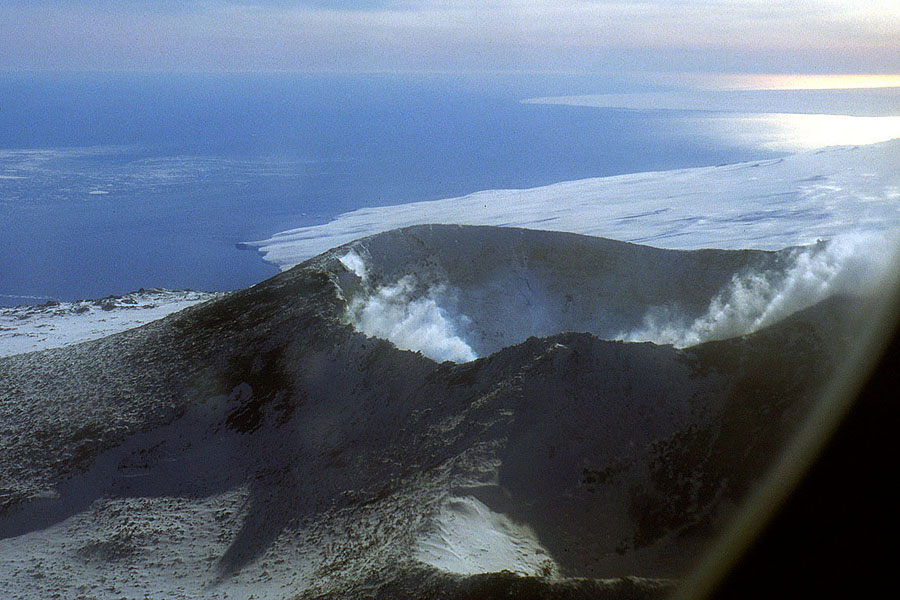Glaciers and volcanoesActive volcanoes around the world are generally associated with the boundaries between tectonic plates. Volcanoes commonly reach a sufficient height to host permanent snow and ice, even in some tropical regions. Glacier-covered volcanoes are potentially very hazardous in populated areas, as the sudden melting of ice during an eruption can generate catastrophic floods and mudflows. Here, we illustrate a range of phenomena associated with glacier-covered volcanoes, in both high and low latitudes. |
 Mount Rainier (4392 m), Washington State, USA carries the largest glacierised area and ice volume within the contiguous United States of America. This substantial ice reservoir is a serious potential threat to cities to the west of the volcano should volcanic activity resume in the future. Avalanche lilies are in the foreground in this summer view taken from the south. JA |  The near conical outline of Osorno in Chile and the floodplain swept by debris flows (lahars) in the foreground. The last known eruption of Osorno took place in 1869. Lahars contain volcanic material from mud to boulder size and are mobilized by snow and ice melt during an eruption or, as in this case, by intensive summer ablation. JA |  Volcanoes which erupt subglacially have a distinct form, with a flat or slightly domed top. Herdubreid in northern Iceland erupted beneath the ice sheet which once covered most of the island during the last glaciation. The thickness of the ice sheet is indicated by the height of the steep cliffs. The meltwater torrent in the foreground is an outflow from Vatnajökull, the largest of the remaining icecaps in Iceland JA |  Past evidence of subglacial eruptions on James Ross Island, near the northern tip of the Antarctic Peninsula, is recorded in these volcanic rocks near Whisky Bay. Stretching back over some 10 million years, these volcanic rocks (called hyaloclastite) were produced as lava made contact with meltwater and broke up explosively into fragments. MH |
 Volcanoes which have been inactive for a long time are subject to erosion, such as by glaciers, as here on Tronador on the border between Argentina and Chile. This volcano has long since lost the cone shape that is typical of composite central volcanoes, as cirque and valley glaciers have eroded substantial parts of the volcanic edifice. JA |  Glaciers around Ruapehu (2797 m), North Island, New Zealand. Failure of an ice dam resulted in a massive debris flow (lahar) which swept away a railway bridge and led to the Christmas 1953 railway disaster. During eruptions of Ruapehu (as in 1995) the lake is also the cause for many lahars. JA |  The eruption of Mount St. Helens, Washington Sate, USA in 1980 resulted in the destruction of its near-perfect conical form and the glaciers on its flanks. 20 years later a new glacier is forming within the crater around the central dome. It is grey because it is covered by ash from the crater walls. Note Mount Rainier in the background. JA |  Vatnajökull 1: The subglacial eruption of the newly named volcano Gjálp, in Iceland in autumn 1996 was one of the most spectacular glaciological events of the last decade. The volcano, initially erupted beneath the ice cap, Vatnajökull (Photo Magnus Gudmundsson) |
 Vatnajökull 2: It created a large lake before sending a large plume of ash skywards. The subglacial lake eventually burst out beneath the glacier, emerging at the terminus of the outlet glacier Skeidarárjökull as a huge flood. (Photo Magnus Gudmundsson) |  Vatnajökull 3: The aftermath of the flood shows a huge channel carved into the ice margin that dwarfs the people and bus on the flood plain. (Photo Andrew Russell). |  The southernmost active volcano in the world is Mount Erebus (3795 m) giving off occasional puffs of steam. The volcano, seen here from New Zealand’s Scott Base, is almost completely ice-covered. MH |  Most volcanoes in the Antarctic Peninsular region are completely ice-covered and thought to be inactive. One of the highest is Mount Haddington (1500 m) on James Ross Island here silhouetted against the setting sun. MH |
 Mount Erebus has an active lava lake in its summit crater, here seen from an aircraft approaching Scott Base. MH | | | |
| Photos: Michael Hambrey (MH), Jürg Alean (JA) |